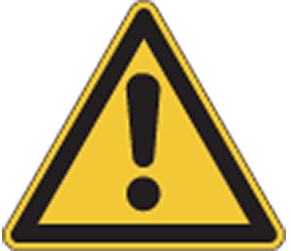|  | Controlled Access Area The System Owner is requested to establish and maintain a Controlled Access Area which in minimum extension is defined by the three dimensional region where the magnetic field exceeds 0.5 mT (see Magnetic Stray Field). Several safety aspects arise that are listed below. | | | Risk of personal injury or death due to effects originating from strong magnetic fields: Establish and maintain a Controlled Access Area. Approaching a strong magnetic field bears various risks that can lead to serious injuries. It is the responsibility of the System Owner (responsible body) to establish and maintain a Controlled Access Area which is defined by the three dimensional region where the magnetic field exceeds 0.5 mT (5 Gauss). People with medical implants or pacemakers or people carrying magnetic parts must not enter the Controlled Access Area. - •
- Establish a Controlled Access Area with minimum size of the 0.5 mT region.
- •
- Train and authorize all personnel that needs to enter the Controlled Access Area. Do not forget to inform facility management, cleaning personnel, or potentially local fire brigade.
- •
- Check authorization regularly and refresh training on safety.
- •
- Refuse and prevent actively people carrying medical implants entering the Controlled Access Area.
- •
- Refuse and prevent actively non-authorized and or non-trained personnel entering the Controlled Access Area. Inform visitors on the potential risk originating from the high magnetic field. Do not leave visitors unattended.
- •
- It is good practice to establish a standard procedure when entering the Controlled Access Area and depose all personal accessories outside that might be affected or become dangerous projectiles.
|
| | | Risk of personal injury or death by projectiles Ferromagnetic objects introduced into the vicinity of the magnetic field become projectiles. Especially in front of the bore, such objects cannot be controlled and become life-threatening projectiles. - •
- No ferromagnetic material may be brought into the vicinity of a MR magnet. If it is unclear if a device contains ferromagnetic material, do not use in the vicinity of the magnet until compatibility has been proven. Always be aware of the strong and sudden attractive force on ferromagnetic materials mainly at the entrance of the magnet bore.
- •
- Do not wear or carry ferromagnetic objects on your person or in your pockets, for example watches, pens, scissors, …
- •
- Do not use gas tanks as for example oxygen, nitrogen, or helium tanks within the Controlled Access Area.
- •
- Do not use ferromagnetic cleaning tools in the Controlled Access Area.
- •
- Be especially cautious with sharp or massive objects, i.e. scissors, knives, needles, tools, or non MR compatible animal accessories.
- •
- Never examine samples that contain ferromagnetic materials.
|
| | | Risk of personal injury or death The magnetic field of the superconducting magnet remains on even when the MR instrument is powered off. - •
- All safety measures associated with the Controlled Access Area have to be observed even when the MR instrument is powered off.
|
| | | Risk of injury and or severe damage of the magnet Accidentally attracted ferromagnetic material stuck in the magnet may be only removed without risk of injury or damage to the system when discharging the magnet. Contact your local Bruker Service. |
| | | Hazard by untrained and unauthorized persons performing work at the magnet Persons working at the magnet must be trained and authorized. Thus, installation, initial commissioning, retrofitting, repairs, adjustments or dismantling of the magnet must only be carried out by Bruker Magnet Service. Note the difference between Bruker Service and Bruker Magnet Service team. |
| | | Dizziness when moving the head at the entrance of the magnet bore Do not move your head at or close to the entrance of the magnet bore. A temporary feeling of drowsiness, dizziness, or metallic taste may result. These effects become stronger the faster the movements are. |
| | | Risk of Fire Ensure a general prohibition of smoking or open fire in the area where the instrument is installed. For MR instruments, this applies to the Controlled Access Area and in the technical room. - •
- For MR instruments, only non-magnetic fire extinguishers equipped with carbon-dioxide are to be used in the Controlled Access Area.
|
| | Malfunction of laboratory equipment sensitive to magnetic fields Within the Controlled Access Area, the MR instrument can - 1.
- interfere with electronic devices so that they might not work as intended
- 2.
- be influenced by electronic devices so that image quality can be affected
- •
- Always check accessories located in the Controlled Access Area for MR compatibility.
|
| | Potential damage of devices by strong magnetic field. The magnetic field can - 1.
- erase magnetic data media, e.g. disks, memory sticks, credit cards
- 2.
- destroy mechanically-sensitive components, e.g. watches, hearing aids, cameras
- •
- Always check accessories that shall be used within the Controlled Access Area for compatibility with magnetic fields.
|
|





